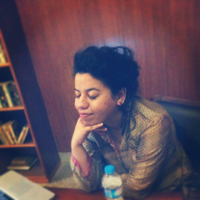More about Étant donnés: 1° la chute d'eau, 2° le gaz d'éclairage
- All
- Info
- Video
- Shop

Contributor
What may appear to be an exhibitionist passed out post-coital in the great outdoors is actually one of Marcel Duchamp’s greatest psychological teases.
Discovered posthumously, this tableau was quite the shocker for those who thought Duchamp had given up his career as an artist and devoted his life to playing chess. While that’s not a bad way to go, the trickster Duchamp had been secretly working on this little number as his final shenanigan, leaving audiences mystified one last time.
The outward appearance of this tableau is deceiving. Unless you’re already aware of the mystery it obscures, you might saunter past the plain wooden door behind which this eerie scene lies. Eyeholes carved into this door allow only one peeping Tom at a time to peek in and get his fill of kinky thrill. You’ve got this splayed, naked lady resting in a bed of twigs and grass with the one hand holding up a gas lamp. No one knows what the lamp symbolizes but it’s appeared in Duchampian drawings before. Her lady bits are not quite anatomically correct and have the appearance of a violent wound, giving an ominous air to the whole situation. So, what’s the story behind this dark diorama?
The sauciest theory has got to be the one that framed Duchamp as a homicidal maniac. Two writers, Mark Nelson and Sarah Hudson Bayliss, fancied themselves the Nancy Drews of the art world and got it in their heads that Étant donnés looked suspiciously similar to the famous Black Dahlia Murder of 1947. Seemed to them that Duchamp got sketching for this work right after photos of the crime scene where the actress Elizabeth Short was found dead and badly mutilated were widely circulated. Some say Man Ray, who had an S&M streak, acquired the photos and passed them on to Duchamp.
This and many other wild connections made in Nelson and Bayliss’s book The Exquisite Corpse: Surrealism and the Black Dahlia Murder make the theory seem quite plausible. It’s all very True Detective…but I just don’t buy it. It’s like someone saying your granddaddy (or grandDADA in this case) is a killer! Still, who knows? The truth is out there.
Featured Content
Here is what Wikipedia says about Étant donnés
Étant donnés (Given: 1. The Waterfall, 2. The Illuminating Gas, French: Étant donnés: 1° la chute d'eau / 2° le gaz d'éclairage) is a 1966 assemblage by Marcel Duchamp. It was his last major artwork, surprising viewers and critics who had widely believed he had given up art; he was previously pursuing competitive chess which he had been playing for almost 25 years. The artwork is a tableau, visible only through a pair of peepholes—one for each eye—in a wooden door, of a nude woman lying on her back on a hill with her face hidden, legs spread, holding a gas lamp in the air in one hand against a landscape backdrop.
Duchamp worked in secrecy on the artwork from 1946 to 1966 in his Greenwich Village studio. It is composed of an old wooden door, nails, bricks, brass, aluminium sheet, steel binder clips, velvet, leaves, twigs, a female form made of parchment, hair, glass, plastic clothespins, oil paint, linoleum, an assortment of lights, a landscape composed of hand-painted and photographed elements and an electric motor housed in a cookie tin which rotates a perforated disc. The Brazilian sculptor Maria Martins, who had Duchamp as a lover from 1942 to 1949, served as the model for the female figure in the piece, and his second wife, Alexina (Teeny), served as the model for the figure's arm.
Duchamp prepared a "Manual of Instructions" in a 4-ring binder explaining and illustrating how to assemble and disassemble the piece.
Anne d'Harnoncourt, a young curator at the Philadelphia Museum of Art and later its director, orchestrated the acquisition and transfer of the piece to Philadelphia. According to the artist's wishes that the work be installed and viewed after his death, Duchamp's widow Alexina Duchamp and his step-son Paul Matisse installed the work and made it available to the public at the Philadelphia Museum of Art in 1969, a year after Duchamp's death.
Check out the full Wikipedia article about Étant donnés















